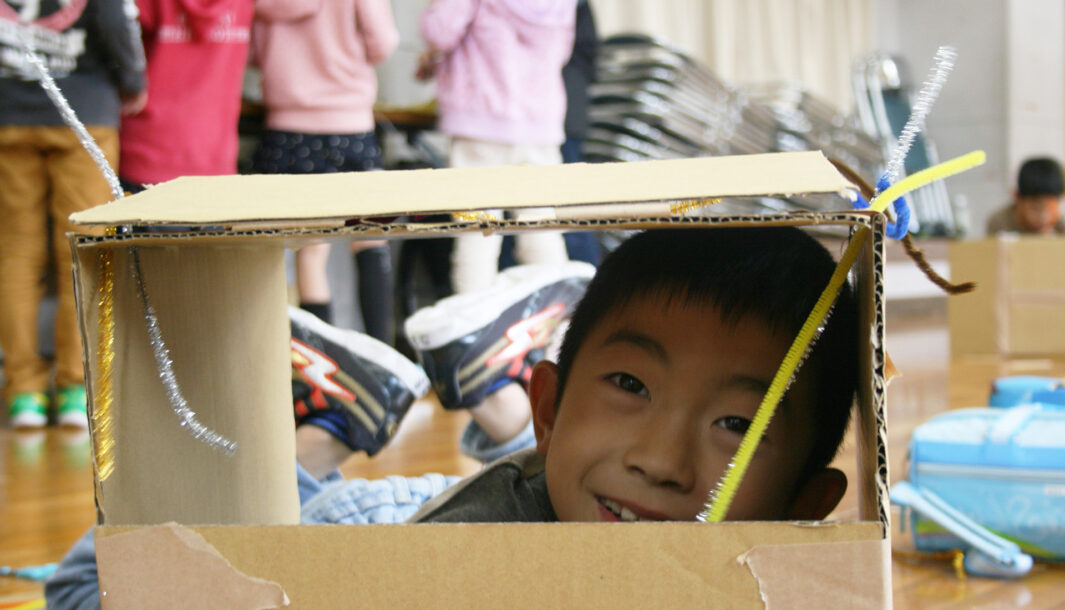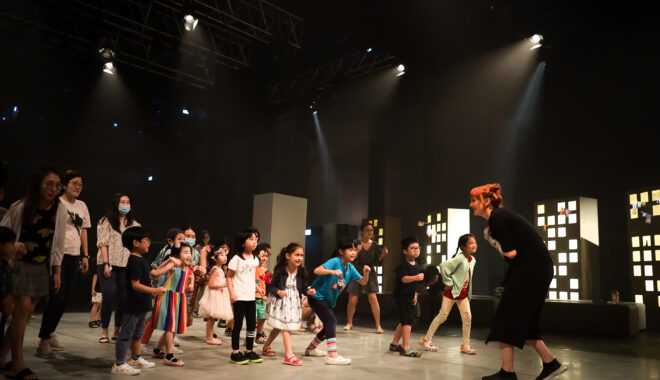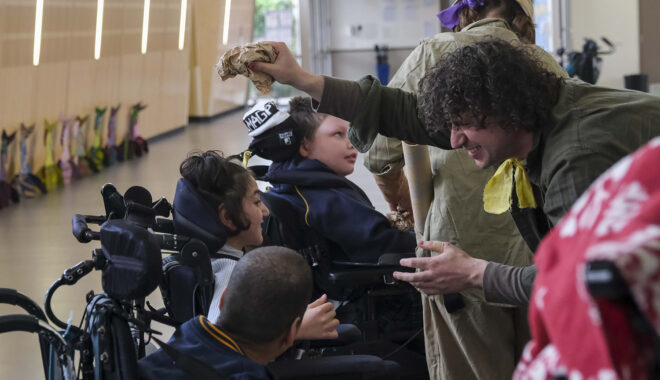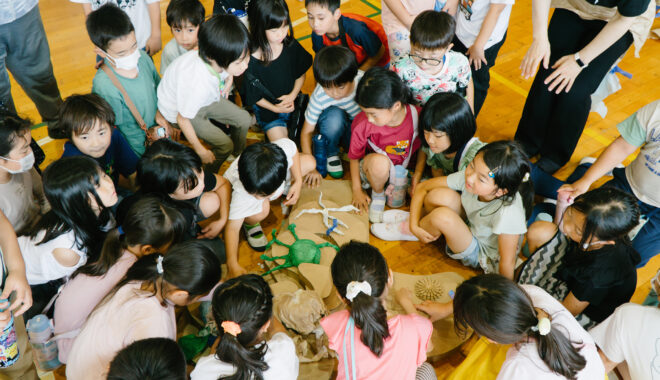24 May 2021 Education News
How does creative play complement and challenge classroom education?

By Cat Sewell
There was an area of the classroom that seemed little used. Containers gathering dust on forgotten wooden shelves. I had been visiting this primary school class over a number of weeks facilitating play-based learning sessions and never seen a child go near it. In the containers were counters, clear and coloured plastic discs that felt good in the hand by the handful. The touch of them sparked my curiosity. And so, the following week, I gave the instruction to the class that for this session, we would only be exploring and playing with this shelf of counters.
Over the next half an hour students laid patterns, pretended to have shops and restaurants, flicked and caught counters and shone light through the coloured plastic. Two boys stood out in my memory in particular. These were 8 year old boys, energetic, often a bit ‘disruptive’ in class and hard to engage. They took themselves over to a corner and proceeded to invent their own game with the counters. An active maths game; with counting, scores and rules to follow. When I came over they very proudly showed and explained the game to me. When we had time for group sharing at the end of the session, the boys confidently stood in front of the class and showed and explained the game to all. And, most hearteningly, the following week, their class teacher said that the whole class had been playing it as part of mathematics all week!
This example has long stayed in my mind as a clear indication of the power of play, and of allowing play to guide and formulate learning in children. As Jean Piaget (1950) said: “Play is the answer to the question, ‘How does anything new come about?’. In this scenario, we have a number of elements coming together to show how play and creativity both complement and challenge classroom education.
When children are given time and space to play, to experiment and create freely, we allow them room in their bodies, hearts and minds to grow. So much of the time and space experienced by children in educational institutions, (indeed often at home and in leisure time too) is structured, pressured and defined. There is little room for mistakes, for trying something just for the sake of it. For the boys in this classroom, it was the time and space to play with no goal that allowed new ideas to form.
Creativity and play are inextricably linked (Googliff et al, 2017). In children, I often think they are one and the same thing. And both are imperative for human development. The brain learns by doing and imagining; and “nothing lights up a child’s brain like play.” (Brown, 2008). Quite literally, the brain is forming neural connections when children play. Interestingly, the brain lights up even when imagining doing something, such as in the experiment with the piano player imagining playing: their brain scans showed almost all the same brain activity apart from a small area in charge of motor control (Pascual-Leone, 2003). Where is the room for imagining in our classrooms? For open creativity and play? As the late, great Sir Ken Robinson (2006) noted: “Imagination is the source of every form of human achievement. And it’s the one thing that I believe we are systematically jeopardizing in the way we educate our children and ourselves.”
Another element that was interesting on that day was the intentional limiting of resources. Instead of playing with all the different materials in the room, they were only to play with the materials on this one shelf. It was precisely the limitation that sparked the creativity. The boundaries narrowed the focus, limited the choices, and in doing so opened up deeper thinking and divergent ideas. The students were more likely to collaborate and share the materials, or practice social skills to be able to collaborate and share.
A similar argument is made for families at home, or early years centres, to rotate toys and materials instead of having them all out at once. Personally, I think both have their merits – sometimes it is wonderful to have many different materials to fit together in incongruent ways, or to return again and again to an old favourite. What is important for educators to think about, though, is that the quality of materials, of space, very much effect what can be done with them; their inherent creativity, or playfulness. For example, if you have an abundance of counters available, the class will play in a very different way than if they had to share just 10. If they had only a very small area to play in, or were outside in the sandpit, or under a table, the ideas and games would be different. Not necessarily better or worse, just different.
Certainly, the best materials for enhancing play and creativity are what are often referred to as ‘open-ended materials’(Daly & Beloglovsky, 2015). This simply means objects that can be used in many different ways, by many different people. Open-ended materials can be used across age groups, genders, cultures and abilities, and are also often cheap and readily available. Think cardboard boxes, sticks and leaves, pieces of fabric, balls and blocks to name a few.
Abraham Maslow (1968) writes, “Almost all creativity involves purposeful play.” Would the boys have invented the same game if the lesson was structured as a mathematics class and they were told to ‘invent a game with these counters’? Perhaps they would. Or perhaps they would have felt too much pressure and froze? We will never know. However, we do know that children need to feel safe to play, and within that safety, those boundaries, they can test limits and take risks. The skills of creativity and adaptability are certainly highly sought after in adulthood. For children, “play is training for the unexpected” (Bekoff, 2001) where they practice that adaptability and problem solving. We need to give children repeated chances to play and create in order to thrive.
Finally, we must look at the role of the adults and children in the scenario. What does it say about a teacher’s authority to allow children to play and create freely? What does it say about the child’s agency and internal drive for learning? What if teachers were trained in the art of stepping back, observing and trusting children’s play?
What I loved most about this scenario was that the boys invented something, felt pride in that creation, were able to communicate it to others, and have a direct effect on what and how they were learning at school. The teacher was able to see the value in embracing what the boys had created, and integrating that into further lessons. She could very well have said, ‘that’s great’ and not mentioned it again, but instead provided those boys with an experience of creative learning they likely won’t forget. The open play and other, more structured lessons became linked. Full circle, back and forth, watching and learning – students and teachers parried together.
There is a huge amount of research that points to the benefits of play for children (Whitebread et al, 2017). Increased fine and gross motor skills, communication skills, social skills, balance and coordination, problem solving and team work, greater wellbeing and increased self-regulation. As educators and facilitators, we need to trust that work. By stepping back and observing we can learn a whole lot about the young people in our care, and be inspired ourselves to incorporate creative, playful learning.
“There is no doubt that creativity is the most important human resource of all. Without creativity, there would be no progress, and we would be forever repeating the same patterns.” (De Bono, 1992)
References
Bekoff, Marc. (2001) Mammalian Play: Training for the Unexpected. In The Quarterly Review of Biology 76(2):141-68. PubMed.
Brown, Stuart. (2008) Play is More Than Fun. TED Partner Series video, 26:38. Posted March 2009
Daly, L., & Beloglovsky, M. (2015). Loose parts: Inspiring play in young children. St. Paul, MN: Redleaf Press.
De Bono, Edward. (1992). Serious creativity: Using the power of lateral thinking to create new ideas. London: Harper Collins Publishers
Googliff, G., Canning, N., Parry, J., Miller, L. (Eds.). (2017) Young Children’s Play and Creativity. London: Routledge.
Maslow, A. (1968). Toward a psychology of being (3rd ed.). New York. John Wiley and Sons, Inc.
Pascual-Leone, Alvaro. (2003). The Brain that makes Music and is Changed by it. In I. Peretz & R. J. Zatorre (Eds.), The Cognitive Neuroscience of Music. Oxford University Press
Piaget, Jean. & Piaget, Jean. (1950). The psychology of intelligence. London : Routledge and Kegan Paul
Robinson, K. (2006, February). Do schools kill creativity. In Presentation at TED2006 conference, Monterey, CA.
Whitebread, D., Neale, D., Jensen, H., Liu, C., Solis, S.L., Hopkins, E., Hirsh-Pasek, K., Zosh, J.M. (2017). The role of play in children’s development: a review of the evidence (research summary). The LEGO Foundation, DK.
Biography
Catherine Sewell (B. Creative Arts, M. Creative Arts Therapy) works in play as an artist, facilitator and educator. Her work as a Play Specialist with schools, kindergartens and playgroups sees her not only running play-based sessions with children but also providing professional development sessions for families and teachers, as well as consulting in key strategic roles. Cat has worked with organisations, government, councils and NGO’s to create resources to promote play in written, online and video formats. As an artist, Cat also creates public installations for children and families and does design work for film and theatre. She is Co-Creative Director of the theatre company The Ball Room Projects.







